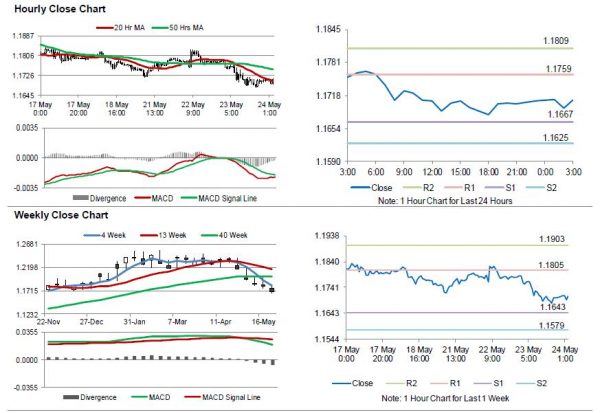For the 24 hours to 23:00 GMT, the EUR declined 0.62% against the USD and closed at 1.1707, after the latest set of economic data pointed to a further slowdown in the Euro-zone’s economic growth.
The flash Markit manufacturing PMI declined more-than-expected to a level of 55.5 in May, hitting a 15-month low level. The PMI had registered a level of 56.2 in the prior month, while markets were expecting for a fall to a level of 56.1. Additionally, the region’s preliminary Markit services PMI unexpectedly eased to a 16-month low level of 53.9 in May, defying market consensus for it to remain unchanged at 54.7.
In other economic news, the Euro-zone’s preliminary consumer confidence index surprisingly deteriorated to a level of 0.2 in May, weighed by economic and political uncertainty across the region. The PMI had registered a reading of 0.4 in the prior month, while market participants had envisaged for a rise to a level of 0.5.
Separately, growth in Germany’s manufacturing sector expanded at its weakest pace since February 2017, after the PMI eased to a level of 56.8 in May, more than market expectations for a fall to a level of 57.9. The PMI had registered a reading of 58.1 in the prior month. Additionally, activity in Germany’s services sector slowed to its lowest level since September 2016, after the PMI unexpectedly dropped to a level of 52.1 in May, confounding market anticipations for it to remain steady at a level of 53.0.
The US Dollar gained ground against a basket of major currencies, after minutes of the Federal Reserve’s (Fed) May meeting indicated that the central bank is on track to raise the benchmark interest rates again at its June meeting, if the economy evolves as expected. Further, it revealed that policymakers would tolerate inflation rising above its 2.0% target for a “temporary period”. However, officials expressed concerns over the fallout from the Trump administration’s trade policies on the US economy.
Gains in the greenback were boosted further, after data revealed that the US preliminary Markit manufacturing PMI recorded an unexpected rise to a level of 56.6 in May, notching its highest level since September 2014. In the preceding month, the PMI had recorded a level of 56.5, while markets had expected for a steady reading. Moreover, the nation’s flash Markit services PMI climbed to a 3-month high level of 55.7 in May, beating market expectations for a rise to a level of 55.0. In the previous month, the PMI had registered a level of 54.6.
On the other hand, the nation’s new home sales unexpectedly eased 1.5% on a monthly basis, to a level of 662.0K in April, defying market expectations for an advance to a level of 680.0K. In the prior month, new home sales had registered a revised level of 672.0K.
In the Asian session, at GMT0300, the pair is trading at 1.1708, with the EUR trading slightly higher against the USD from yesterday’s close.
The pair is expected to find support at 1.1667, and a fall through could take it to the next support level of 1.1625. The pair is expected to find its first resistance at 1.1759, and a rise through could take it to the next resistance level of 1.1809.
Going ahead, traders would focus on Germany’s final 1Q GDP figures as well as GfK consumer confidence index for June, both due to release in a few hours. Later in the day, all eyes would be on the US initial jobless claims and existing home sales data for April.
The currency pair is showing convergence with its 20 Hr moving average and trading below its 50 Hr moving average.














